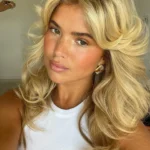Meet Charmaine Poh, The Singapore Artist Inspecting Social Relationships By way of Artwork

It’s been a busy time for Singapore-born, Berlin-based artist Charmaine Poh. With a apply spanning pictures, media and efficiency, Poh explores concepts of company, restore, and the physique. Earlier this yr, Poh was one of many first Singaporean artists to be proven within the sixtieth Worldwide Artwork Exhibition on the Venice Biennale 2024, one of many celebrated occasions within the worldwide artwork world. Extra not too long ago, Poh was introduced as Deutsche Financial institution’s “Artist of the Yr” 2025 and can debut a brand new fee at a solo exhibition at Berlin Artwork Week in September 2025.
As we communicate, Poh tells me that she has freshly returned from a visit to Thailand—with the staff behind unbiased media platform Jom, of which she is the pinnacle of visible tradition and media—and is about to jet set off to Italy, the place she’ll be participating in Visio – European Programme on Artists’ Shifting Photos.
Forward, Poh tells us extra about her beginnings as an artist, the method of constructing her artwork, and the way the notion of household ties into her apply.

Are you able to inform us the way you started your inventive apply?
Charmaine Poh (CP): I didn’t suppose I’d develop into an artist. Once I was finding out Worldwide Relations at Tufts College, I took a category in documentary apply, which concerned documentary pictures, video, audio, and textual content. It was arrange by a lecturer who was a struggle photographer. I rapidly turned obsessive about it, poring over picture books day in and time out, and occupied with the nonetheless picture and its potential.
I used to be so riveted by how being a photographer can change your life: once you’re embedded in a state of affairs, you’re participating with the world round you. You’re dwelling in that second with different folks and that adjustments your life. This wasn’t my main, however I spent just about all my time on this.

I began with the performing arts, and I liked performing as a result of it took me to a different world. It’s important to be totally absorbed within the character’s world and I discovered that pictures and performing have that similarity.
I didn’t perceive what it meant to be an artist. I didn’t come from any background with any generational affect over the humanities, so it was actually a gradual course of.
Once I graduated, I began to endure mentorship programmes and youth alternatives to discover a voice aesthetically and philosophically—all whereas discovering some jobs to become profitable. It was actually about cobbling collectively completely different components of my life, and in 2015-2016, certainly one of my initiatives Room was exhibited much more. In order that was my begin, and it took a very long time, however then every little thing slowly got here collectively.

What are your favorite issues in regards to the mediums of pictures and movie?
CP: (In comparison with pictures), video isn’t a static factor you cling on the wall. The kind of concepts you wish to execute have completely different aspects as you tie collectively audio, shifting picture, and probably efficiency. It turns into much more complicated technically. That’s what my apply got here to after working solely in pictures for 5 years. I began to starvation for different methods to execute my concepts, so it appeared like a pure development. Kin was my first video work.
You’re at present primarily based in Berlin pursuing your PhD in Visible and Performing Arts at Freie Universität Berlin. How has this fed into your inventive apply?
CP: When it comes to grounding my ideas theoretically, the programme’s actually useful. Impartial inventive work can really feel unstructured and countless. With theoretical references and grounding, you possibly can construct a basis for the place you’re going, as a result of there’s an [artistic] canon and methodology. If you wish to break the canon, that’s high quality, since you at all times have some extent of reference to return to.

A lot of your earlier works characteristic photographing portraits of ladies—be it faculty ladies (Room (2016)); the ma jie (Chinese language feminine migrant staff who served as home helpers in Singaporean households from the Nineteen Thirties-Seventies); Taiwanese butch tradition (Fairly Butch (2018)); and girls within the Singaporean workforce (All in her day’s work (2017-2018)). What compelled you to deal with such a broad number of topics?
CP: I didn’t actually take into consideration them as broad; I felt like every portrait spoke to part of the human psyche. Room was about reminiscence, youth, and adolescence, whereas Fairly Butch was lots in regards to the efficiency of id and coming to phrases with masculinity.
The ma jie challenge got here by as an preliminary fee about Chinatown. Some artists and I had been requested to make a piece about Chinatown. The programme tried to attach us with completely different components of Chinatown and I heard somebody say there was a ma jie in a neighborhood centre, and I used to be like, “What is that this?”
I began to analysis and search for them, and I used to be fairly struck by their radical way of life. These ma jie stepped away from marriage and devoted their lives to arduous work, labour, and migration. [Their lives] entailed celibacy and so they underwent a ritual of honour the place they tied their hair up in a sor hei (combing up) ceremony. It’s very under-recognised, and I felt passionately about it as a result of I knew there have been only a few ma jie left. There have been only a few ma jie [when I shot the project], and even fewer now.
I discover a private connection to every challenge. Even when it’s not the lived expertise, there’s an emotional resonance. I discover them fairly private, regardless of spanning backgrounds.

Themes of queerness, care, and belonging take centre stage in Kin, certainly one of your latest works. Filmed in 2021, the brief movie proposes an imaginary protected area for queer life in Singapore. What drove you to discover this concept — particularly in the course of the pandemic?
CP: This was one other accident. I had a buddy who had a number of commercial-grade lenses for a number of additional days and so they requested me if I wished to do one thing with them. That was the way it began. It was two weeks from the day I discovered in regards to the lenses to the shoot. We borrowed somebody’s home and we shot for half a day. We gathered vehicles and everybody did it totally free. Everybody was additionally itching to do one thing.
This was probably in response to the pandemic; the thought of the significance of security in shared areas and discovering belonging. Numerous queer folks, in the event that they reside with their household, might not have the help they want. So this movie was a gesture in the direction of a risk. It was a type of cases the place I felt pictures wouldn’t suffice.

The idea of household performs a significant function in What’s softest on the planet rushes and runs over what’s hardest on the planet, which gives a glimpse of the struggles of queer parenthood in Singapore. What was your inspiration behind pursuing the challenge?
CP: I had been discussing an enlargement of Kin with Adriano Pedrosa (the Curator of the sixtieth Worldwide Artwork Exhibition on the Venice Biennale 2024) and I believed the perfect method could be an element two. With queer parenthood, I believed it might be a chance to increase on the narrative of the nurturing of latest life. It felt extra cosmological, as a result of debates surrounding nature and nurture are at all times positioned upon queer folks.
I had been studying Ursula Okay. Le Guin’s rendition of the Chinese language classical textual content, Dao De Jing, and spending a number of time within the lakes round Berlin. All this subconsciously flowed into how I approached the challenge. I didn’t wish to deal with the queer mother and father solely as documentary topics, however to convey out these questions on world-making, the pure world, and the way we’re all interconnected.

I already knew one of many mother and father, so I slowly contacted the remainder from there. I had been engaged on these associated tales for a number of years, and I felt that it was crucial for this matter as some folks had been just a little cautious of getting their identities recognized—particularly in terms of defending their kids, worrying about their kids getting bullied or folks of their office understanding.
I feel there’s nonetheless this worry as a result of [these parents] sit in a gray space, the place certainly one of them is legally not associated to the kid. So there are a number of query marks round family-making in Singapore, which knowledgeable this method to not present faces within the work.
What does “household” imply to you?
CP: To me, household is a communal train of generosity, solidarity, non-judgment and care. These ideas have actually helped me in my life; I couldn’t have been capable of do any of this alone.
You’re additionally a member of the Asian Feminist Studio for Artwork and Analysis (AFSAR), which archives up to date feminist discourse and artist analysis. How did you become involved with that and why was this an necessary trigger so that you can be part of?
CP: I received concerned with that by becoming a member of AFSAR’s research group for the e book Artwork and Cosmotechnics by Hong Kong thinker Yuk Hui. AFSAR is a component collective, half community, and half platform that has these research teams primarily based on idea and inventive apply. From there, it opened a number of concepts of how we view the world.
There’s additionally one other research group known as Asia as Precept, which is about disentangling earlier notions of what Asia is, in addition to what feminism and queerness are. It goes into these non-Western notions of those necessary questions.
To spherical out the interview, how would you describe your apply in three phrases?
CP: Buoyant, tenacious, and emotive.
This text was first seen on Grazia Singapore.
For extra on the most recent in artwork and chief interviews, click on right here.








